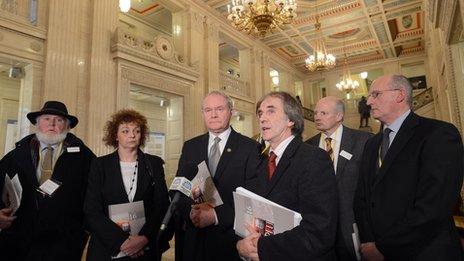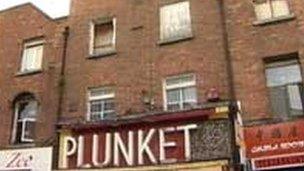1916 Easter Rising leaders' descendants offer sympathy
- Published

The delegation included relatives of rebellion leader, Padraig Pearse, and a great-grandson of James Connolly.
The great grandson of James Connolly, a leading figure in the 1916 Easter Rising, has extended his sympathy to the family of murdered prison officer, David Black.
James Connolly Heron was visiting Stormont, along with other relatives of those who led the rising.
They are asking MLAs to back a campaign to preserve historic buildings linked to the battle.
He said it would be insensitive to comment on the wider politics.
But he added: "It's difficult on a day like this in terms of the tragedy that has befallen that family for us to make comment on that, we obviously extend our condolences to the family in this desperate hour."
Deputy First Minister Martin McGuinness - who invited the delegation to Stormont - said the responsibility for dealing with the issue of dissident republicans rested with elected leaders.
The delegation also included relatives of rebellion leader, Padraig Pearse, as well as Joseph Plunkett and Seán MacDiarmada.
They met Martin McGuinness and the culture minister, Carál Ni Chuilín.
For the first time, the relatives have taken their campaign outside Dublin in their bid to preserve the "lanes of history" including Moore Street, around the historic GPO site.
The delegation chose Stormont as the first venue to step up their campaign to win support across the island, as they press the Irish government to ensure the site becomes a cultural and historic quarter.
'National treasure'
Reading a prepared statement, James Connolly Heron told reporters in Stormont's Great Hall: "The state must now act. The GPO Moore Street battlefield is an all-Ireland heritage site. Indeed, it belongs to Irish people everywhere."
While a plan to build a retail centre in Moore Street is not now going ahead, there is still uncertainty about the site.
The General Post Office on Dublin's O'Connell Street now houses a museum, but the site around Moore Street is in the hands of the state agency, Nama.
Mr McGuinness said people were energised about the need to preserve the site which he described as a "national treasure" with tourist potential.
And he recalled recent efforts to preserve the site at the Battle of the Boyne.
Kay McDermott, grand niece of the leader Sean MacDiarmada, lives in West Belfast and supports the campaign.
She likened the site to the Titanic Quarter, pointing out people would come from all over the world to learn about Irish history.
The relatives spent a few hours at Stormont, passing the statue of Carson, Craigavon and a portrait of Ian Paisley on the way.

The final headquarters of the rising, 16 Moore Street, has been designated as a national monument
Their appeal for all political leaders to assist the campaign however has not inspired the DUP to help. A DUP spokesman said the Dublin site was an internal matter for the Irish government.
The delegation also toured James Connolly's former house on Belfast's Falls Road.
The buildings between 14 and 17 Moore St, Dublin, where some of the rebels met for the last time before surrendering to the British, were designated as national monuments, external in 2007.
The Easter Rising was a brief, violent insurrection that began in Dublin on Easter Monday, 24 April 1916.
It cost the lives of 450 people - more than half of whom were civilians - and resulted in widespread destruction of much of the capital's inner city.
The rebellion was defeated by the British forces within days, but the event is widely viewed as the catalyst for the Irish War of Independence two years later, which was followed by the partition of Ireland and the establishment of an Irish free state.
Fifteen rebel leaders who survived the fighting were executed by the British in the aftermath of the rising.
- Published8 August 2012
- Published14 May 2012